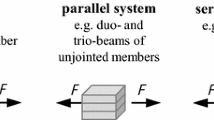Abstract
In the present paper a probabilistic approach for modelling the tensile strength and tensile stiffness properties of timber boards and finger joint connections is presented. The approach includes the geometrical setup of timber boards (the position of knot clusters) and a hierarchical representation of two strength and stiffness related indicators. One indicator to describe the mean material properties of timber boards and one indicator to describe the lengthwise variability due to knots. Based on the two indicators the tensile strength and tensile stiffness of timber board sections and finger joint connections are estimated using material models. The application of the approach is illustrated. For this purpose, finger joint connections and timber boards with different length are simulated and the material properties are compared with values proposed in the literature.









Similar content being viewed by others
References
Barrett J, Lam F, Lau W (1995) Size effects in visually graded softwood structural lumber. J Material Civil Eng 7(1):19–30
Benjamin JR, Cornell CA (1970) Probability, statistics, and desision for civil engineers. MCGraw-Hill Book Company
Blaß H, Frese M, Glos P, Denzler J, Linenmann P, Ranta-Maunus A (2008) Reliability of spruce-glulam with modified set-up (in German), vol 11. KIT Scientific Publishing
Colling F (1990) Bending strength of glulam beams depending on strength related parameters (thesis, in German). Versuchsanst. für Stahl, Holz und Steine
Colling F, Dinort R (1987) The knot frequency of conifer timber used in glulam factories (in German). Holz Roh- Werkst 45(1):23–26
Czmoch I, Thelandersson S, Larsen H (1991) Effect of within member variability on bending strength of structural timber. In: Proceedings of the 24th Meeting, International Council for Research and Innovation in Building and Construction, Working Commission W18 - Timber Structures, Oxford, United Kingdom, CIB-W18, Paper No. 24-6-3
DIN 4074–1 (2008) Strength grading of wood—Part 1: Coniferous sawn timber; German version
Ehlbeck J, Colling F, Görlacher R (1985) Influence of fingerjointed lamellae on the bending strength of glulam beams (in German). Holz Roh- Werkst 43(8):369–373
EN 1194 (1999) Timber structures—glued laminated timber—strength classes and determination of characteristic values; German version
EN 14081–4 (2009) Timber structures—strength graded structural timber with rectangular crosssection—Part 4. In: Machine grading—grading machine settings for machine controlled systems; German version
EN 1912 (2012) Structural timber—strength classes—assignment of visual grades and species; German version
EN 338 (2010) Structural timber—strength classes; german version
EN 384 (2004) Determination of characteristic values of mechanical properties and density; german version
EN 408 (2003) Timber structures—structural timber and glued laminated timber - Determination of some physical and mechanical properties; German version
Faber M (2012) Statistics and Probability Theory. In Pursuit of Engineering Decision Support, vol 18. Springer
Fink G (2014) Influence of varying material properties on the load-bearing capacity of glued laminated timber—Diss. ETH NO. 21746. PhD thesis, ETH Zurich, Zurich, Switzerland
Fink G, Kohler J (2011) Multiscale Variability of Stiffness Properties of Timber Boards. In: ICASP Applications of Statistics and Probability in Civil Engineering. Zurich, Switzerland
Fink G, Kohler J (2012) Non-destructive test to determine the modulus of elasticity of timber boards (in German). IBK Report No. 339, ETH Zurich, Zurich
Fink G, Kohler J (2014) Model for the prediction of the tensile strength and tensile stiffness of knot clusters within structural timber. Eur J Wood Prod 72(3):331–341
Giudiceandrea F (2005) Stress grading lumber by a combination of vibration stress waves and x-ray scanning. In: Proceedings of the 11th International Conference on Scanning Technology and Process optimization in the wood Industry (ScanTech 2005), Las Vegas
Görlacher R (1984) A new method for determining the modulus of elasticity of timber (in German. Holz Roh- Werkst 42:219–222
Görlacher R (1990) Stress grading of laminates according to DIN 4074 by measuring longitudinal vibrations (in German). Bauingenieur 65:517–522
Heimeshoff B, Glos P (1980) Tensile Strength and MOE in Bending of Spruce Laminates (in German). Holz Roh- Werkst 38(2):51–59
Isaksson T (1999) Modelling the variability of bending strength in structural timber. PhD thesis, Lund Institute of Technology
JCSS (2006) Probabilistic Model Code Part III - Resistance Models (3.05 Timber). http://www.jcss.byg.dtu.dk/Publications/Probabilistic_Model_Code
Kersken-Bradley M, Rackwitz R (1991) Stochastic modeling of material properties and quality control. In: JCSS Working Document, IABSE-publication
Kline D, Woeste F, Bendtsen B (1986) Stochastic model for modulus of elasticity of lumber. Wood and Fiber Science 18:228–238
Köhler J, Faber MH (2004) Proposal for a probabilistic model code for design of timber structures. In: Proceedings of the 37th Meeting, International Council for Research and Innovation in Building and Construction, Working Commission W18 - Timber Structures, Edinburgh, UK, CIB-W18, Paper No. 37–104-1
Köhler J, Sørensen JD, Faber MH (2007) Probabilistic modeling of timber structures. Structural safety 29(4):255–267
Kohler J, Brandner R, Thiel A, Schickhofer G (2013) Probabilistic characterisation of the length effect for parallel to the grain tensile strength of central european spruce. Engineering Structures 56:691–697
Lam F, Varoglu E (1991a) Variation of tensile strength along the length of lumber. Wood Sci Technol 25(5):351–359
Lam F, Varoglu E (1991b) Variation of tensile strength along the length of lumber. Wood Sci Technol 25(6):449–458
Madsen B, Buchanan AH (1986) Size effects in timber explained by a modified weakest link theory. Canadian Journal of Civil Engineering 13(2):218–232
Pellicane P, Stanfill-McMillan K, Tichy R (1987) Effects of knots near the fingers of finger-jointed dimension lumber. Forest products journal 37(5):13–16
Samson M (1985) Potential of finger-jointed lumber for machine stress-rated lumber grades. Forest Products Journal 35(7/8):20–24
SIA 265–1,(2009) Timber Structures - Supplementary Specifications. German version, Schweizer Ingenieur- und Architektenverein, Zurich, Switzerland
Taylor SE, Bender DA (1991) Stochastic model for localized tensile strength and modulus of elasticity in lumber. Wood and Fiber Science 23(4):501–519
Weibull W (1939) A statistical theory of strength of materials. Nr. 151, Royal Swedish Institute for Engineering Research
Author information
Authors and Affiliations
Corresponding author
Rights and permissions
About this article
Cite this article
Fink, G., Kohler, J. Probabilistic modelling of the tensile related material properties of timber boards and finger joint connections. Eur. J. Wood Prod. 73, 335–346 (2015). https://doi.org/10.1007/s00107-015-0895-z
Received:
Published:
Issue Date:
DOI: https://doi.org/10.1007/s00107-015-0895-z




